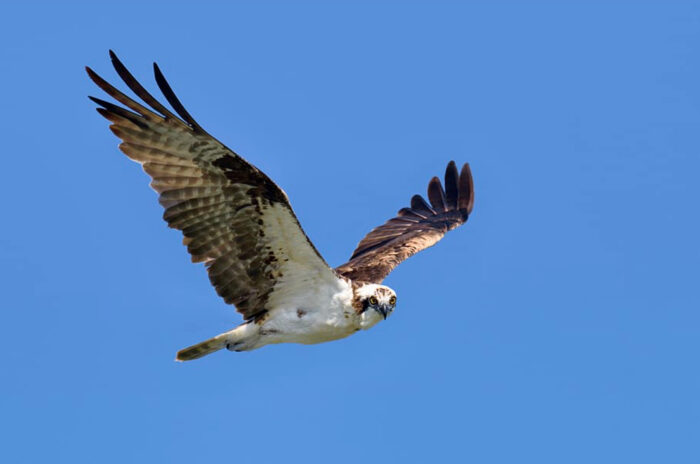
Peter Goodman: The Messy Reality of ‘Made in America’
The construction of a giant factory complex in Arizona was supposed to embody the Trump administration’s ability to bring manufacturing back to the United States.…
Thought Leader: Peter Goodman

World Migratory Bird Day (WMBD) is a joint global campaign to raise awareness and action for international cooperation to conserve migratory birds. In honor of the 2023 theme “Water: Sustaining Bird Life,” the Environment for the Americas, Conservation of Migratory Species of Wild Animals, and the African-Eurasian Migratory Waterbird Agreement highlighted ten bird species to demonstrate the importance of water to birds and how they depend on aquatic ecosystems to survive and thrive. This WMBD PI is calling attention to these vital ecosystems and some of the important migratory birds that rely on them.
Water serves as the foundation for sustaining all life on our planet, and migratory birds are no exception. They rely on water in its various forms—like lakes, swamps, rivers, marshes, coastal wetlands, and more—for breeding, refueling during migration, and as habitats. But because of climate change, pollution, and human action, these crucial aquatic ecosystems are at risk.
According to the UN, wetlands are among the ecosystems with the highest rates of decline. Since 1970, 35 percent of the world’s wetlands have been lost due to myriad factors, including agriculture, overexploitation of resources, construction, overfishing, invasive species, and climate change. All these factors deprive migratory birds of critical stopover points across the world during migration.
Rufous Hummingbirds are found primarily in North America. During their migration, you can find Rufous Hummingbirds in mountain meadows, and when winter comes, they flock to Mexico in shrubby areas and thorn forests. They primarily feed on nectar from colorful tubular flowers, which they use their slender bills to access.
Although the species is considered common, the Rufous Hummingbird’s population is declining due to habitat loss, vegetation loss, and threats along their long migratory route. These small birds also fall victim to glass window collisions, outdoor cats, and other predators. Rufous Hummingbirds are on the Partners in Flight’s Yellow Watch List for birds most at risk of extinction and have been identified as a “Tipping Point” species. According to the WMBD website, that means their populations have declined by 50 percent and are projected to decline an additional 50 percent by 2050.
Northern Shovelers depend on both freshwater and saltwater wetlands to thrive. They are born among the reeds and aquatic plants in swamps and marshes during the spring, and then Northern Shovelers fly to South America in the fall. Northern Shovelers don’t just exist in the Americas; they spend the winter throughout Europe, Africa, and India.
According to Partners in Flight Databases , Northern Shovelers have a global breeding population of about 5.9 million and have had stable populations, making them a species of low conservation concern. However, the deterioration of coastal wetlands and the creation of agricultural wastewater ponds that impact water quality pose serious threats to their well-being.
American White Pelicans are large migratory birds that live and breed mainly on islands in freshwater lakes or in the northern Great Plains in shallow wetlands. They favor coastal wetlands and inlets to forage in shallow waters close to their nesting spots and rest on exposed sandbars.
American White Pelicans rebounded from low populations between 1966 and 2019, according to the North American Breeding Bird Survey and are considered a low conservation concern. These birds are highly sensitive to human interactions especially when near their breeding colonies. American White Pelicans will abandon their nests due to disturbances. Human disturbance, habitat destruction, and water management of the areas they breed in pose major threats to American White Pelicans.
Barn Swallows hatch in springtime near bodies of water where they are able to hunt for insects. These birds feed on insects almost exclusively while in flight. According to the North American Breeding Bird Survey , populations of aerial insectivores, like swallows, are declining. Researchers hypothesize that the decline in insect populations, possibly due to the use of pesticides and other chemicals, may be the cause of the decline in swallows.
However, Barn Swallows are considered a low conservation concern because swallows, in general, have expanded their breeding range due to human-made structures and because humans have encouraged the birds to nest near their homes because they feed on insects that are a nuisance to humans.
The osprey, also known as a sea, river, or fish hawk, is a large bird of prey that feeds mostly on fish. These birds greatly depend on healthy bodies of water for their meals. The species likes to nest in tall treetops near wetlands. Ospreys are widely distributed throughout different habitats in North America. You can find ospreys in mangroves, marshes, lakes, and even saline lagoons. Chemical waste, trash, and pollution threaten the waterways that ospreys’ diets and lives depend on.
Despite the various threats the species face, ospreys are known as a conservation success story. Their populations grew approximately 1.9 percent per year from 1966 to 2019, according to the North American Breeding Bird Survey . After noticing the population’s decline in the early 1950s to 1970s due to pesticides poisoning the birds, ospreys are now considered a low concern due to conservation efforts. In 1972 , as a result of successful legal arguments, the United States Environmental Protection Agency imposed a ban on DDT. They cited its adverse effects on the environment, wildlife, and its potential human health risks. After the ban, the osprey population rebounded.
Despite the name, Northern Waterthrushes can actually be found in North, South, and Central America. These birds like to frequent wet habitats with dense ground coverage, like marshes, bogs, and mangroves. Northern Waterthrushes forage for aquatic insects and salamanders at the water’s edge. The species are threatened by the loss of mangroves in coastal areas of Mexico, Central America, the Caribbean, and northern South America. These coastal areas have been populated by ports for boats which contaminate the water with fuel, chemical waste, and trash.
Northern Waterthrushes are numerous, and their population has grown by an estimated 54 percent since 1970, according to Partners in Flight , which makes them a low risk of conservation concern. However, the species die each year in large numbers due to cats and from collisions with large buildings, in addition to pollution, pesticides, and drainage of wetlands.
Wilson’s Phalaropes are a type of shorebird that breed in wetlands. They travel in large flocks and start their migration usually in saline or alkaline lakes in North America. During the winter, they fly to mainly the highlands of Bolivia and Argentina but also other parts of South America. As a shorebird, Wilson Phalaropes feed on small crustaceans and shrimp, primarily from the surface of the water.
Wilson’s Phalaropes are considered a low conservation concern but have seen a slight decline in population since 1966 . This is due to the degeneration of their wetlands and human development around where they nest.
Dickissels are a common bird in North America’s grass plains and wetlands. The Dickissel is a long-distance migratory species that can be found in Central and South America in the winter. They are omnivores and forage for invertebrates and seeds in grassy plains. Dickissels nest in natural grasslands and have had to greatly adjust their habits due to the large-scale conversion of native grasslands to agricultural land for crops.
The increased availability of hayfields have provided Dickissels a different breeding habitat but since hayfields are mowed often they are usually mowed before the nesting birds have time to fledge their offspring. The conversion of these native grasslands into agricultural land also encompasses different aquatic ecosystems that Dickissels and other species depend on. The greatest threat to the species occurs on their wintering grounds in Venezuela. Dickissels have very high populations in the llanos region and have been regarded as pests to the grain crops grown there since the 1960s . Many farmers have deliberately killed them by illegally poisoning and spraying the birds with pesticides and other toxic chemicals. This caused major mortality among Dickissels. But since this species has an extremely large population and range, they are considered a low concern for conservation, despite the constant attacks against them.
Magellanic Penguins call temperate regions of South America home, usually in coastal forests, grasslands, and offshore rocky islands. Each spring, Magellanic Penguins make the journey across the Atlantic from Brazil to Argentina. They create burrows for their nests they will return to each year. They typically choose to nest on shoreline grasslands so their nests can be covered but also to be close enough to the ocean to forage for fish.
Water is a huge part of Magellanic Penguins’ daily lives. They have specialized wings for swimming at high speeds and for long distances. Penguins spend much of their lives in and near water, where they feel the threats from overfishing and water pollution greatly. Many penguins die from getting caught in fishing nets, plastic, and trash in the water. According to the Cornell Lab of Ornithology, the main threat to Magellanic Penguins are oil spills and oil pollution. From studies conducted during the 1980s and early 1990s, between 20,000 and 40,000 Magellanic Penguins died each year along the coast of Argentina due to oil pollution.
Despite the many obstacles Magellanic Penguins face and their prior classification of near threatened since 2004, recent data including population trends suggest that the species is stable overall, so they are now considered a low conservation concern globally.
Yellow-billed Cuckoos can be found in the Americas in woodland habitats near streams and marshes. Cuckoos eat mostly insects, but in summer and fall, Yellow-billed Cuckoos also forage on wild fruits like blackberries and elderberries. In British Columbia, Oregon, Washington, and other areas in the west, much of the species’ riparian habitats, like riverbanks and streambanks, have been converted to farmland and housing. This has caused a significant population decline. Yellow-billed Cuckoo birds were once common in California’s Central Valley, but due to habitat loss, constraints on their breeding have occurred, and they have been reproducing in much smaller numbers.
According to the Cornell Lab of Ornithology, the western North American population of Yellow-billed Cuckoos is a candidate for federal endangered status despite the species being globally considered of low conservation concern due to their global breeding population estimated at about 9.6 million . Also, as long-distance migrators, Yellow-billed Cuckoos are vulnerable to collisions with tall structures like buildings, cell towers, and wind turbines.
Peter Goodman: The Messy Reality of ‘Made in America’
The construction of a giant factory complex in Arizona was supposed to embody the Trump administration’s ability to bring manufacturing back to the United States.…
Thought Leader: Peter Goodman
Peter Zeihan: The Death of the US Tech Sector
We’re doing a two-part series on the tech sector. Today, we’ll be looking at the disruption caused by deglobalization and Trump’s policies. The gadgets and…
Thought Leader: Peter Zeihan
David Frum breaks down 2025’s defining moments
Leading author, journalist, and thinker David Frum and The Hub’s editor-at-large Sean Speer reflect on the most significant political developments of 2025. They discuss a…
Thought Leader: David Frum

